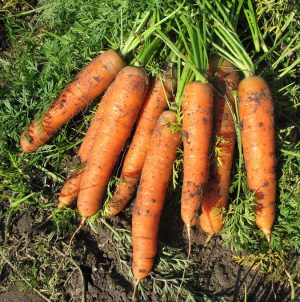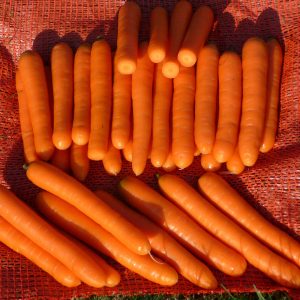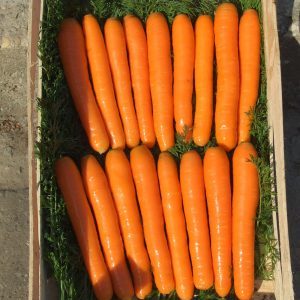Late-ripening table hybrid of Bolero f1 carrots: description and features of cultivation
Carrots are a popular agricultural crop cultivated in Russia for a long time. Even in the old days, our ancestors called her "the queen of vegetables" for her benefits and nutritional value.
Breeders are constantly improving the properties and indicators of this crop. Of the total, I would like to highlight the Bolero F1 carrots. Why this hybrid is in demand among Russian gardeners, what features it has, how to grow it, read our article.
The content of the article
Description of the hybrid carrot Bolero F1

Bolero F1 is one of the best fruit plants that are great for industrial and private cultivation. The hybrid is distinguished by unique morphological characteristics, and their combination makes the culture very popular in the modern market.
Origin and development
Bolero F1 is the result of painstaking work of French breeders from Vilmorin company. The most productive varieties of the producer obtained over the past decades were taken as a basis.
Carrots perfectly tolerate short-term frosts, rains and droughts. If we compare the hybrid with the varieties Tushon or Baltimore, the advantage will clearly be on the side of the Bolero.
Chemical composition, trace elements and vitamins, useful properties
Carrots contain carotene in an amount of 12-15 mg per 100 g of product, dry matter - up to 12% of the total mass, sugar - 8% of the total mass.
Trace elements:
- calcium, potassium, sodium, magnesium, phosphorus, iron, zinc, chlorine, fluorine, iodine, chromium;
- vitamins of group E, C, K, H, B, A;
- essential oils.
The nutritional value:
- proteins - 1, 3 g;
- fats - 0.2 g;
- carbohydrates - 6, 6 g;
- water 89 g;
- dietary fiber - 2, 2 g;
- ash - 1, 2 g;
- starch - 0.2 g;
- organic acids - 0.3 g.
The beneficial properties of carrots are as follows:
- enhances immunity, helps to resist viruses and infections;
- has a beneficial effect on the nervous system;
- restores intestinal microflora, relieves dysbiosis;
- removes toxins, reactive substances from the body;
- has a beneficial effect on male potency;
- normalizes the work of the gastrointestinal tract;
- reduces the risk of developing cancer;
- removes stones from the kidneys and gallbladder.
Attention! Carrots are not recommended for people who are allergic to this product, as well as those suffering from stomach and duodenal ulcers, inflammation in the small intestine, pancreatitis.
Ripening period
Bolero F1 is a late-ripening highly productive variety that belongs to the table carrot of the Nantes type. The growing season from sowing seeds to fruiting lasts 115-130 days.
Yield
The variety boasts a high yield. So in a temperate climate, a hybrid gives from 5 to 6 kg per 1 sq. m of nutritious root crops.
Disease resistance
Bolero F1 is a very resistant hybrid to infections and diseases.There is an increased immunity to cercospora, powdery mildew, Alternaria.
Important! Gardeners should remember that such characteristics are achieved only with proper cultivation and care. If you do not take into account the advice and recommendations of experienced farmers, the expected indicators will not be achieved.
Characteristics, description of appearance, taste

In terms of external characteristics and geometric parameters, the root crop is referred to the Berlikum-Nantes cultivar... The shape of the fruit resembles a neat cylinder. Its length varies within 15-20 cm, and its weight is 100-200 g. The tip has a regular rounded shape.
Due to the high carotene content, carrots have a rich orange color. Excellent taste is perfectly manifested both when the root vegetable is eaten fresh, and after boiling, frying, conservation and stewing. The pulp pleases a person with incredible juiciness and sweetness.
Which regions is best suited for
The variety prefers regions with a moderately cold continental climate. The crop is recommended to be grown in the Central regions of Russia, on the territory of Ukraine and Belarus.
The main advantages and disadvantages of a hybrid
The Bolero F1 hybrid can rightfully be proud of its merits. These include:
- high productivity;
- resistance to major cruciferous diseases;
- resistance to drought, heat and cold;
- suitability for long-term storage;
- guarantee of germination of planting material;
- excellent commercial characteristics and excellent quality of the crop;
- universality of application.
Like any other crop, Bolero carrots have some disadvantages. Namely, the unsuitability of seed for germination at home and winter sowing.
What is the difference from others
Bolero F1 is noticeably distinguished by its neat shape of root crops, unpretentious care, high yield. It is for these features that the hybrid is loved by vegetable growers.
Features of planting and growing
Each variety and hybrid has its own unique agrotechnical features that must be taken into account when growing. Bolero F1 carrots require sowing no earlier than mid-May. So the soil will warm up enough and be saturated with moisture.
Preparing for landing
Experienced farmers recommend compulsory preparation of planting material before sowing. It is recommended to disinfect the seeds so that the sprouts acquire protection against bacterial and fungal infections.
The seeds are soaked in one of the solutions of your choice:
- 1% potassium permanganate - exposure time from 10 to 20 minutes;
- 70% alcohol - about 10 minutes;
- 3% hydrogen peroxide - 8-10 hours.
After that, the seeds require activation. It is enough to soak the planting material in clean warm water at room temperature. Procedure time - 10-12 hours.
Reference. To achieve maximum germination, it is recommended to place the seeds in a biostimulant solution. For example, drugs - "Epin" and sodium humate showed good results. Be sure to carefully read the instructions before use.
Ground requirements
The main condition for the successful cultivation of Bolero F1 is the presence of nutritious loose soil. Therefore, it is important to take care of its creation in the fall. It is enough to add humus to the soil in the amount of 0.5 buckets per 1 sq. m.
In the spring, carefully dig up the site, form low beds. The best soil for planting carrots is sandy loam. If the soil is heavy, add sand, peat or treated sawdust.
Attention! Experienced farmers have found that manure in the soil affects the bitterness and roughness of the root crop.
Predecessors
The best predecessors are tomatoes, onions, lettuce, potatoes and cucumbers. After cucumbers, you can sow carrots after 2 years.
Timing, scheme and landing rules
The most important landing rules for the F1 Bolero are:
- Sow seeds in rows. The distance between them should be 15 cm, between seeds in one row - 3-4 cm, and the seeding depth - 1-2 cm.
- After the end of planting work, water the ridge abundantly and cover with agrofibre.
Important! Sowing is recommended in mid or late May. By this time, the soil will warm up well, get rid of groundwater, and be enriched with nutrients.
Growing features
Growing Bolero F1 carrots is not difficult. The main thing is to comply with the seeding rate, take into account the nuances of care, protect the sprouts from diseases and pests.
The optimal seeding rate is 0.5 g per 1 sq. m. We will consider the remaining points further.
The nuances of care

Regular care of carrots is the key to a rich and tasty harvest. Activities include watering, weeding, feeding, pest and disease control.
Watering mode
Carrots require regular watering. Here are some guidelines:
- until mid-July, water the plants 1-2 times a week in the evening;
- then reduce the frequency of moistening by 2 times.
Important! Water the soil so that it is saturated with moisture to a depth of 30 cm. Only in this way will you achieve high-quality nutrition of the root system. The result is dense and tasty root vegetables.
Thinning and weed control
Timely thinning is an effective way to increase the yield and commercial quality of root crops. The thickening of the plantings will force the plants to fight among themselves for living space. When the sunrises form 2-3 true leaves, it is important to perform the first thinning (keep the distance between the shoots at 3 cm). Then repeat the procedure after 20-25 days (distance between plants - 7 cm).
Consider important nuances during events:
- do work in the early morning or late evening;
- Water the beds thoroughly before removing sprouts.
Do not forget about weeding and loosening the soil to a depth of 10 cm. These procedures significantly reduce the likelihood of pests and diseases.
Top dressing
For the entire growing season, the root crop needs 2 dressings. The first fertilizer is applied 20 days after sowing the seeds, and the second one - 60 days later.
The best feeding option is a complex mixture. The recipe is as follows: dilute 2 cups of wood ash in 10 liters of water, 1 tbsp. l. nitrophosphate, 20 g of potassium nitrate, 20 g of carbamide, 15 g of superphosphate. Apply the solution under the root in an amount of 5 liters per 1 sq. m.
Attention! It is not recommended to fertilize plantings with manure or humus. Otherwise, the flesh of the carrot will taste bitter.
Disease and pest control
Bolero F1 is resistant to the main types of diseases. But with improper care to replace the disease and pests become more active.
- Diseases. Phomosis, white rot, gray rot, rhizoctonia, alternaria, bacteriosis, cercospora, brown spot. Phomosis, bacteriosis and cercosporosis are not amenable to treatment. Affected plants are dug up and destroyed. Other types of infections at an early stage are eliminated with the help of fungicides - "Blue Board", "Alett", "Copper oxychloride", "Rovral", "HOM".
- Pests. Carrot fly, flies, umbrella moth, slugs, wireworms, aphids, scoops. For the fight use drugs - "Actellik", "Sharpey", "Tsiper", "Decis Profi".
Important! Use drugs strictly according to the instructions. The wrong dosage of the chemical will kill not only carrots, but also other garden crops.
Harvesting and storage
After a long and painstaking work, it is time to collect carrots. It is important here to wait until the roots are fully ripe. Unripe fruits are characterized by low keeping quality, quickly rot and are affected by various fungi.
How and when to collect
Carrots are harvested in mid-September. By this time, it will acquire a rich shade, taste and excellent density. Root crops are harvested by hand only in dry and sunny weather.
Storage features and keeping quality of the hybrid

Spread the collected fruits in a dry, dark, windless place on a natural bedding. Dry slightly for 3 hours. Remove the tops and place in wooden boxes. The room temperature should be between + 1 ° C and + 10 ° C.
Bolero F1, during long-term storage, perfectly retains its taste and presentation. Root crops can be stored until next spring, or even until summer.
What can be the difficulties in growing
The hybrid in question is easy to grow in any region of Russia. Difficulties may arise for novice gardeners. They are in the seed rate. If the plantings are thickened, the farmer can lose most of the crop (a huge number of shoots will have to be destroyed).
Tips from experienced gardeners
Experienced farmers recommend:
- be sure to disinfect the planting material;
- follow the landing pattern;
- take care of crops.
Simple activities will allow you to enjoy juicy carrots throughout the winter.
Read also:
How to cook pickled eggplant stuffed with carrots and garlic.
How to properly prepare pickled cucumbers with carrots for the winter.
Reviews of summer residents
The hybrid satisfies the requirements of both novice gardeners and experienced farmers.
Natalia, Dubna: «I have been growing the Bolero variety for several years. I really like the carrots - they are long, sweet and juicy. I do not always manage to take care of the plantings on time. However, this does not affect the quality of the crop in any way. Recomend for everybody.".
Anatoly, Krasnoarmeysk: "My family loves fresh carrots. But over the past 2 years, it has been constantly destroyed by the carrot fly. And in one store I was advised to take a hybrid Bolero F1. The result amazed me - for the whole summer I did not see a single pest on the plants. The most interesting fact remains that I have never seen such a rich harvest. My rating is 5 out of 5 ".
Conclusion
Bolero F1 carrots are a striking representative of French selection. The hybrid is unpretentious to care for, has 98% germination, is resistant to diseases and adverse weather conditions. To grow this grade, no farmer experience needed. The main thing is to follow the advice and recommendations, and the culture will surely please with a rich and tasty harvest.